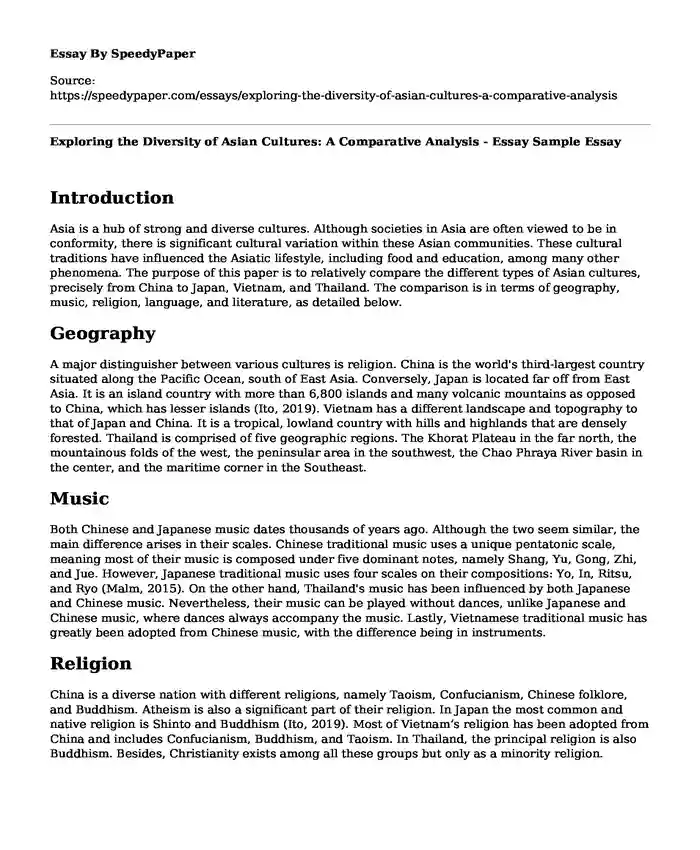Introduction
Asia is a hub of strong and diverse cultures. Although societies in Asia are often viewed to be in conformity, there is significant cultural variation within these Asian communities. These cultural traditions have influenced the Asiatic lifestyle, including food and education, among many other phenomena. The purpose of this paper is to relatively compare the different types of Asian cultures, precisely from China to Japan, Vietnam, and Thailand. The comparison is in terms of geography, music, religion, language, and literature, as detailed below.
Geography
A major distinguisher between various cultures is religion. China is the world's third-largest country situated along the Pacific Ocean, south of East Asia. Conversely, Japan is located far off from East Asia. It is an island country with more than 6,800 islands and many volcanic mountains as opposed to China, which has lesser islands (Ito, 2019). Vietnam has a different landscape and topography to that of Japan and China. It is a tropical, lowland country with hills and highlands that are densely forested. Thailand is comprised of five geographic regions. The Khorat Plateau in the far north, the mountainous folds of the west, the peninsular area in the southwest, the Chao Phraya River basin in the center, and the maritime corner in the Southeast.
Music
Both Chinese and Japanese music dates thousands of years ago. Although the two seem similar, the main difference arises in their scales. Chinese traditional music uses a unique pentatonic scale, meaning most of their music is composed under five dominant notes, namely Shang, Yu, Gong, Zhi, and Jue. However, Japanese traditional music uses four scales on their compositions: Yo, In, Ritsu, and Ryo (Malm, 2015). On the other hand, Thailand's music has been influenced by both Japanese and Chinese music. Nevertheless, their music can be played without dances, unlike Japanese and Chinese music, where dances always accompany the music. Lastly, Vietnamese traditional music has greatly been adopted from Chinese music, with the difference being in instruments.
Religion
China is a diverse nation with different religions, namely Taoism, Confucianism, Chinese folklore, and Buddhism. Atheism is also a significant part of their religion. In Japan the most common and native religion is Shinto and Buddhism (Ito, 2019). Most of Vietnam’s religion has been adopted from China and includes Confucianism, Buddhism, and Taoism. In Thailand, the principal religion is also Buddhism. Besides, Christianity exists among all these groups but only as a minority religion.
Language
The Chinese language is entirely different from the Japanese. Grammatical rules, words, and pronunciations differ from the Chinese using the Hanzi language, which is among the oldest writing forms (Turturici, 2020). The language mostly used for communication in China is Mandarin. The Japanese language has three alphabets, namely Kanji, Hiragana, and Katakana. In Thailand, Mon-Khmer and Thai language are the primary languages spoken. The Vietnamese also use the Mon-Khmer.
Literature
Chinese literature is inclusive of poetry, scientific writings, philosophy, fiction, and religious works. Early Japanese literature was scribbled in Chinese characters. They also include poetry with the earliest poems dating back to the 4th century in the Manyoshu (Keene, 2016). Vietnamese literature is slightly different from Chinese and Japanese because it also includes oral literature like folk stories. Thai literature is mainly adopted from the Indian culture, precisely the Buddhist ideology. They changed Ramayana to Ramakien, which is a translation to Siamese. In general, most of the literature was based on the history of the dynastic eras.
Why Asian Americans are Thought as a Monolithic Group
The main reason that I can attribute Asian Americans being viewed as monolithic is that they resemble one another. We often have thoughts that Asian Americans, although from different cultures, are related and are like one huge extended family. Asian groups such as the Chinese and Japanese are also a collectivistic culture, where their people privately reserve their culture. They are also loyal and rigid to their culture leading to thoughts of being monolithic.
References
Malm, W. P. (2015, September 17). Japanese music. https://www.britannica.com/art/Japanese-music/Influence-of-Tang-dynasty-China.
Ito, M. (2019, July 10). Major Cultural Differences Between China and Japan. Asian Minato. https://asianminato.com/10-major-cultural-differences-between-china-and-japan.
Turturici, A. (2020, July 30). Similarities and Differences Between Chinese and Japanese. Sapore di Cina. https://www.saporedicina.com/english/similarities-differences-chinese-japanese/.
Keene, D. (2016, July 25). Japanese literature. Encyclopedia Britannica. https://www.britannica.com/art/Japanese-literature.
Cite this page
Exploring the Diversity of Asian Cultures: A Comparative Analysis - Essay Sample. (2023, Nov 14). Retrieved from https://speedypaper.net/essays/exploring-the-diversity-of-asian-cultures-a-comparative-analysis
Request Removal
If you are the original author of this essay and no longer wish to have it published on the SpeedyPaper website, please click below to request its removal:
- Free Essay on Gang Violence
- Free Essay on Homeland Cyber Security
- Free Essay Sample: Gender Biases in The Sweat and Cat in the Rain
- Persuasion Analysis Paper, Free Example for Students
- Free Essay Dedicated to Edward Bernays as a Pioneer of Public Relations
- Interventions for Helping Metro Company Cope with The Expected Expansion - Essay Sample
- Paper Sample on Cultural Diversity in Education: Policies, Practices, and the Pursuit of Equity
Popular categories





